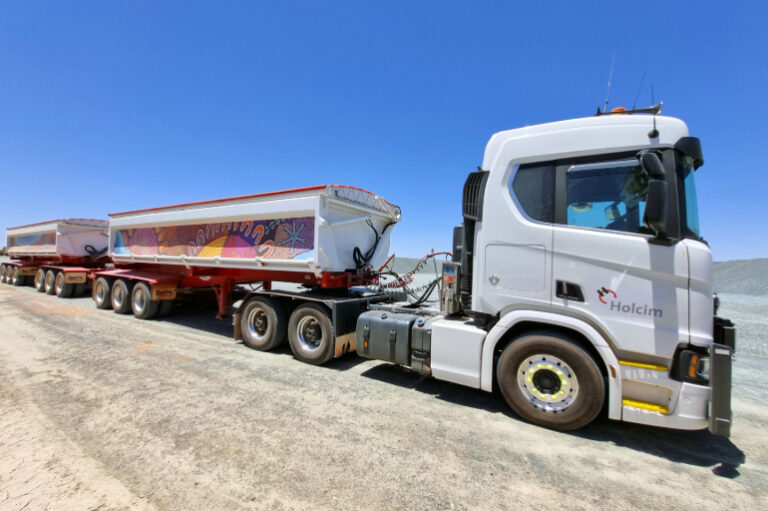Holcim, Scania and HYDI have partnered to decarbonise the logistics chain in Australia’s remote Pilbara region, using hybrid prime movers that run on both diesel and hydrogen.
The Holcim operation in the Pilbara is one that deals with big weights and gruelling conditions. Quarry materials are transported from the Turner River, Newman and Nickol Bay quarries to concrete batch plants using Scania R620 V8 145-ton rated prime movers, each pulling up to 100 tonnes in triple configuration.
To help advance Holcim’s ambition to reduce diesel consumption and emissions, two prime movers were retrofitted with HYDI Hydrogen on Demand HY2500 vertical units that produce hydrogen for controlled delivery to internal combustion engines.
Holcim says it has seen fuel consumption reductions of up to 15% when hauling payloads of up to 100 tonnes, but the company’s Logistics Manager for Aggregates in Western Australia, Adam Evans, explains that this is only the tip of the iceberg.
“This is only part of the benefit of the hybrid system,” he said.
“On top of the fuel consumption figures, excitingly, we’re seeing the additional emission reductions of 17% less carbon dioxide (CO2), 80% lower diesel particulate matter (DPM), 22% lower nitrogen oxides (NOX), and 25% lower carbon monoxide (CO).”
Holcim is now set to install HYDI systems in two additional prime movers as well as some of its contractor fleet throughout Western Australia.
“We are also exploring options to have HYDI units installed on other equipment including diesel generators and heavy mining equipment,” Mr Evans said.
Mr Evans says Scania has been a committed and enthusiastic partner throughout the trial and is even honouring the original repair and maintenance package provided with the vehicles.
“Scania stepped up to the project, made sure we had all the vehicle and system information needed for a smooth installation of the HYDI units, and are eager to help us extend the project even further,” he said.
Developed in Australia across more than a decade, the innovative technology delivers improved machinery performance by increasing torque, a reduction in fuel consumption, a cleaner burn that reduces engine soot and extends oil and filter service intervals, and lower harmful emissions – including DPM, CO2 and CO.
The HYDI unit produces hydrogen from distilled water using electrolysis, via a proton exchange membrane, drawing only a small electrical input from the host engine while in operation. Hydrogen then supplements the diesel fuel to create a cleaner and more complete combustion process, with the amount of hydrogen produced optimised for the capacity and application of the engine.
The system provides the capability to convert heavy, diesel-powered machinery into cleaner, more cost-efficient equipment at a fraction of the cost of replacement.
“HYDI’s technology harnesses the benefits of hydrogen in an efficient, affordable and sophisticated way scaled to apply to multiple applications,” HYDI Managing Director, John Wilson said.
The HYDI Hydrogen on Demand system can be simply and quickly integrated into the existing diesel technology of Scania vehicles, the manufacturer explains.
“In Australia we have to say that realistically the general availability of reliable, affordable hydrogen as a fuel for heavy haulage is still some way off, particularly regarding use in remote mining operations,” Scania Australia General Manager of Mining, Robert Taylor said.
“As a result, the HYDI Hydrogen on Demand solution does appear to be providing a real-world and affordable solution for our customers who want or need to make an immediate reduction in fuel burn and their carbon footprint emissions across their transport functions.”
The investment and installation of this leading transitional technology into its fleet further highlights Holcim’s commitment to emissions reduction on its journey to reducing absolute Scope 3 Greenhouse Gas (GHG) emissions 90% by 2050, from a 2020 base year.






